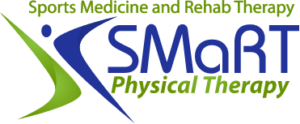How to Tell if a Herniated Disc is the Reason for Your Back Pain

If You’re Living with a Herniated Disc, Physical Therapy Can Help!
How do you tell if you have a herniated disc or just back pain? One telltale sign is the location of the pain. The pain from a herniated disc is usually felt in the lumbar spine – that is the lower part of your spine.
With herniated discs, the pain in the back may also radiate to the thighs, buttocks, or calves. A herniated disc can cause pain whether you’re sitting or moving around. A cough or sneeze can also cause pain by putting pressure on pinched nerves.
If this sounds like you, you may be living with a herniated disc. Contact SMaRT Physical Therapy today to learn how our services can help relieve your symptoms!
Herniated discs, defined
As stated by the American Association of Neurological Surgeons,
“A herniated disc (also called bulged, slipped or ruptured) is a fragment of the disc nucleus that is pushed out of the annulus, into the spinal canal through a tear or rupture in the annulus. Discs that become herniated usually are in an early stage of degeneration. The spinal canal has limited space, which is inadequate for the spinal nerve and the displaced herniated disc fragment. Due to this displacement, the disc presses on spinal nerves, often producing pain, which may be severe.”
Common symptoms of herniated discs include, but are not limited to:
- Burning, numbness, or tingling in the back, buttock, legs, and/or feet
- Pain that intensifies when sitting, coughing, sneezing, or bending
- Pain when bending or twisting
- Weakness in the legs
How can physical therapy treat a herniated disc?
A physical therapist will instruct you on how to perform specific exercises to alleviate pain and strengthen muscles associated with a herniated disc. Ultrasound therapy, deep tissue massage, ice and heat treatment, stretching exercises, electrical muscle stimulation, and aerobic exercises are common parts of physical therapy programs for herniated disc pain.
Deep tissue massage employs pressure to alleviate muscle spasms and tension caused by a herniated disc. Heat therapy aids in the delivery of nutrients and oxygen to the affected area, promoting healing. Cold therapy aids in the reduction of inflammation and the alleviation of pain.
Exercise for a herniated disc focuses on core stability, flexibility, and muscle strengthening. Remember that core muscles help to support the spine. Learning proper stretching and flexibility techniques will make it easier for your body to move. Muscle-strengthening builds a strong support system for the spine and aids in pain relief.
A physical therapist will also teach you self-care principles and exercises that you can do at home. This way, you can avoid further injury while also benefiting from the long-term effects of physical therapy. You are an active participant in your recovery with physical therapy.
Signs your back pain may be caused by a herniated disc
According to The National Institute of Health, “The highest prevalence [of herniated disc cases] is among people aged 30-50 years, with a male to female ratio of 2:1. There is little evidence to suggest that drug treatments are effective in treating herniated discs.”
A visit to your doctor is a good way to find out if you have a herniated disc. Your doctor will most likely perform a physical exam and may even order an x-ray. While an x-ray will not reveal a herniated disc, it can help rule out other possible causes of your pain, such as a fracture.
If your doctor recommends an MRI, this test can produce detailed 3-D images of the spinal cord and determine whether or not you have a herniated disc. It also indicates which nerves are impacted.
The function of spinal discs is to act as a shock absorber during daily activities such as walking, sitting, lifting, and running. Each disc is made up of two rings: a soft inner ring and a tough outer ring. If the outer ring is damaged, the inner ring may protrude and cause pain.
Herniated discs are commonly caused by weak muscles, aging, being overweight, or leading a sedentary lifestyle. A herniated disc can also occur if you make a sudden quick motion, causing the disc to protrude.
Get started on a treatment plan today
If you have a herniated disc or suspect you have one, please contact SMaRT Physical Therapy right away. We can assist you in resuming your normal life!
